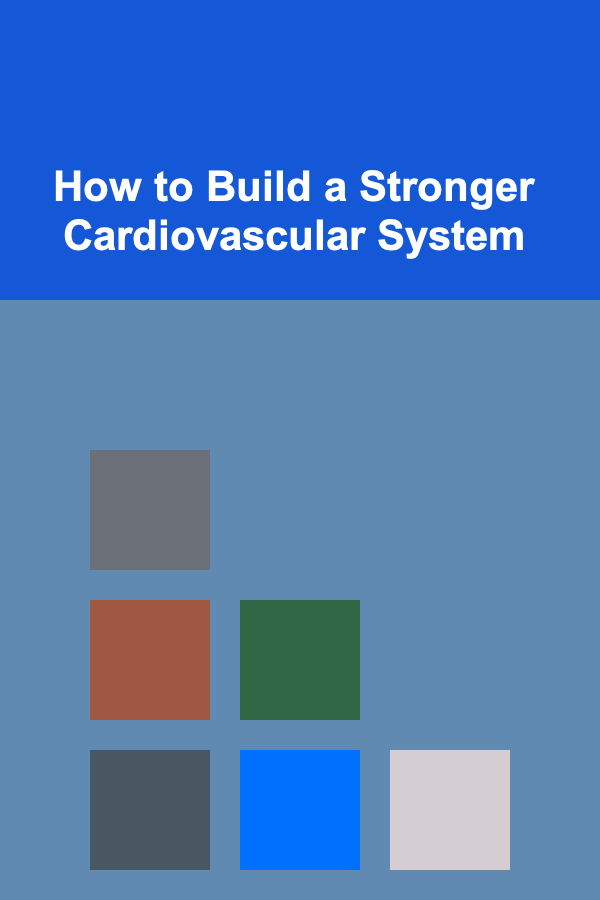
How to Build a Stronger Cardiovascular System
ebook include PDF & Audio bundle (Micro Guide)
$12.99$11.99
Limited Time Offer! Order within the next:

The cardiovascular system, comprised of the heart and blood vessels, is the engine that powers our lives. It's responsible for transporting oxygen, nutrients, hormones, and immune cells throughout the body, while simultaneously removing waste products like carbon dioxide. A robust cardiovascular system is crucial not just for athletic performance, but also for overall health and longevity. A weakened cardiovascular system increases the risk of heart disease, stroke, high blood pressure, and a host of other chronic conditions. Fortunately, the cardiovascular system is remarkably adaptable and responsive to lifestyle changes. This article delves into the science-backed strategies you can implement to build a stronger, more resilient cardiovascular system.
Understanding the Cardiovascular System
Before diving into the strategies, it's essential to grasp the fundamental workings of the cardiovascular system.
- The Heart: This muscular organ acts as a pump, contracting rhythmically to propel blood through the circulatory system. It consists of four chambers: the right atrium and ventricle (receiving deoxygenated blood from the body and pumping it to the lungs), and the left atrium and ventricle (receiving oxygenated blood from the lungs and pumping it to the rest of the body). The strength and efficiency of the heart muscle directly impact its ability to deliver blood effectively.
- Blood Vessels: These form a complex network of tubes that carry blood throughout the body. There are three main types:
- Arteries: Carry oxygenated blood away from the heart. They have thick, elastic walls to withstand the high pressure generated by the heart's contractions.
- Veins: Carry deoxygenated blood back to the heart. They have thinner walls than arteries and contain valves to prevent backflow.
- Capillaries: Tiny, thin-walled vessels that connect arteries and veins. It is at the capillary level that oxygen and nutrients are exchanged with the surrounding tissues, and waste products are collected.
- Blood: This fluid carries oxygen, nutrients, hormones, immune cells, and waste products. It consists of red blood cells (carrying oxygen), white blood cells (fighting infection), platelets (involved in blood clotting), and plasma (the liquid portion of blood). The composition and viscosity of blood can impact cardiovascular health.
When these components function optimally, the cardiovascular system efficiently delivers oxygen and nutrients, keeping the body energized and healthy. However, factors like inactivity, poor diet, smoking, and stress can damage the system, leading to various cardiovascular diseases.
Exercise: The Cornerstone of Cardiovascular Health
Regular exercise is arguably the most potent tool for building a stronger cardiovascular system. It challenges the heart and blood vessels, forcing them to adapt and become more efficient.
Aerobic Exercise
Aerobic exercise, also known as cardio, involves activities that elevate your heart rate and breathing for a sustained period. These activities strengthen the heart muscle, improve blood vessel function, and increase the efficiency of oxygen delivery.
- How it Works: During aerobic exercise, your heart beats faster and stronger, pumping more blood with each beat. This increased blood flow delivers more oxygen to your muscles and tissues. Over time, this stimulates the heart to become larger and stronger, leading to a lower resting heart rate and improved cardiac output (the amount of blood the heart pumps per minute). Aerobic exercise also helps to dilate blood vessels, making them more flexible and efficient at transporting blood.
- Types of Aerobic Exercise:
- Running: A high-impact exercise that provides a great cardiovascular workout. Start with walking or jogging and gradually increase the intensity and duration.
- Swimming: A low-impact exercise that is gentle on the joints. It works all major muscle groups and provides excellent cardiovascular benefits.
- Cycling: Another low-impact option that strengthens the legs and improves cardiovascular fitness.
- Brisk Walking: A simple and accessible exercise that can be incorporated into your daily routine.
- Dancing: A fun and engaging way to get your heart rate up and improve cardiovascular health.
- Hiking: A great way to enjoy the outdoors while getting a cardiovascular workout.
- Rowing: Works both upper and lower body while providing a great cardio workout.
- Recommendations: The American Heart Association recommends at least 150 minutes of moderate-intensity aerobic exercise or 75 minutes of vigorous-intensity aerobic exercise per week. You can break this down into smaller chunks, such as 30 minutes of moderate-intensity exercise most days of the week. It's crucial to listen to your body and gradually increase the intensity and duration of your workouts to avoid injury. Also consider incorporating interval training.
Interval Training
Interval training involves alternating between short bursts of high-intensity exercise and periods of lower-intensity recovery. This method is highly effective for improving cardiovascular fitness in a shorter amount of time.
- How it Works: High-intensity intervals challenge the cardiovascular system to work at its maximum capacity, forcing the heart to adapt and become stronger. The recovery periods allow the body to recover and prepare for the next interval. This cycle of intense effort and recovery can significantly improve VO2 max (the maximum amount of oxygen your body can utilize during exercise), a key indicator of cardiovascular fitness.
- Examples of Interval Training:
- Running: Sprint for 30 seconds, followed by 1 minute of jogging or walking. Repeat for 10-15 minutes.
- Cycling: Cycle at high resistance for 30 seconds, followed by 1 minute of cycling at low resistance. Repeat for 10-15 minutes.
- Swimming: Swim at a fast pace for 30 seconds, followed by 1 minute of slow swimming or treading water. Repeat for 10-15 minutes.
- Considerations: Interval training is more demanding than continuous aerobic exercise, so it's essential to start slowly and gradually increase the intensity and duration of the intervals. It's also crucial to warm up properly before each workout and cool down afterwards. Consult with your doctor or a qualified fitness professional before starting an interval training program, especially if you have any underlying health conditions.
Strength Training
While aerobic exercise is primarily associated with cardiovascular health, strength training also plays a vital role.
- How it Works: Strength training involves lifting weights or using resistance to build muscle mass. While it doesn't elevate your heart rate as dramatically as aerobic exercise, it does improve cardiovascular health in several ways. It can lower blood pressure, improve cholesterol levels, and enhance insulin sensitivity, all of which are beneficial for the cardiovascular system. Furthermore, increased muscle mass increases the body's metabolic rate, contributing to weight management which indirectly reduces strain on the heart.
- Examples of Strength Training:
- Weightlifting: Using dumbbells, barbells, or weight machines to perform exercises like squats, deadlifts, bench presses, and overhead presses.
- Bodyweight Exercises: Using your own body weight as resistance to perform exercises like push-ups, pull-ups, squats, and lunges.
- Resistance Bands: Using elastic bands to provide resistance during exercises.
- Recommendations: The American Heart Association recommends incorporating strength training exercises at least two days per week, working all major muscle groups (legs, back, chest, shoulders, arms). Focus on proper form to avoid injury.
Diet: Fueling a Healthy Heart
What you eat has a profound impact on your cardiovascular health. A heart-healthy diet is rich in fruits, vegetables, whole grains, and lean protein, while being low in saturated and trans fats, cholesterol, sodium, and added sugars.
Key Dietary Components for Cardiovascular Health:
- Fruits and Vegetables: Packed with vitamins, minerals, antioxidants, and fiber, fruits and vegetables help protect against heart disease. Aim for at least five servings per day. Choose a variety of colors to ensure you're getting a wide range of nutrients.
- Whole Grains: Provide fiber, which helps lower cholesterol and blood pressure. Choose whole grains over refined grains (like white bread and white rice). Examples include brown rice, quinoa, oats, and whole-wheat bread.
- Lean Protein: Essential for building and repairing tissues. Choose lean sources of protein, such as fish, poultry (skinless), beans, lentils, and tofu.
- Healthy Fats: Focus on unsaturated fats, such as monounsaturated and polyunsaturated fats. These fats can help lower cholesterol levels. Good sources include olive oil, avocados, nuts, seeds, and fatty fish (like salmon and tuna).
- Omega-3 Fatty Acids: A type of polyunsaturated fat that is particularly beneficial for cardiovascular health. They can help lower triglycerides, reduce inflammation, and prevent blood clots. Good sources include fatty fish, flaxseeds, chia seeds, and walnuts.
- Fiber: Soluble fiber, in particular, can help lower LDL cholesterol ("bad" cholesterol). Good sources include oats, beans, apples, and citrus fruits.
Foods to Limit or Avoid:
- Saturated and Trans Fats: These fats can raise LDL cholesterol and increase the risk of heart disease. Saturated fats are found in red meat, processed meats, full-fat dairy products, and some tropical oils (like coconut oil and palm oil). Trans fats are often found in processed foods, fried foods, and baked goods.
- Cholesterol: While dietary cholesterol has less of an impact on blood cholesterol than saturated and trans fats, it's still wise to limit your intake. High-cholesterol foods include organ meats, egg yolks, and shellfish.
- Sodium: Excess sodium can raise blood pressure. Limit your sodium intake to less than 2,300 milligrams per day. Avoid processed foods, which are often high in sodium.
- Added Sugars: Excess sugar can contribute to weight gain, high triglycerides, and inflammation, all of which can increase the risk of heart disease. Limit your intake of sugary drinks, processed foods, and desserts.
Hydration
Staying adequately hydrated is crucial for overall health, including cardiovascular health. Water helps maintain blood volume, which is essential for efficient blood circulation. Dehydration can thicken the blood, making it harder for the heart to pump. Aim to drink at least eight glasses of water per day.
Lifestyle Factors: Beyond Exercise and Diet
While exercise and diet are critical, other lifestyle factors can significantly impact cardiovascular health.
Stress Management
Chronic stress can wreak havoc on the cardiovascular system. It can raise blood pressure, increase heart rate, and promote inflammation. Finding healthy ways to manage stress is essential for protecting your heart.
- Techniques for Stress Management:
- Meditation: A practice that involves focusing your attention and calming your mind.
- Yoga: A combination of physical postures, breathing techniques, and meditation that can help reduce stress and improve flexibility.
- Deep Breathing Exercises: Simple techniques that can help calm your nervous system and lower your heart rate.
- Spending Time in Nature: Exposure to nature has been shown to reduce stress hormones and improve mood.
- Hobbies and Activities You Enjoy: Engaging in activities that you find relaxing and enjoyable can help reduce stress and improve your overall well-being.
- Social Support: Connecting with friends and family can provide emotional support and help you cope with stress.
- Professional Help: If stress is overwhelming, consider seeking help from a therapist or counselor.
Sleep
Getting enough sleep is crucial for cardiovascular health. Sleep deprivation can raise blood pressure, increase heart rate, and promote inflammation. Aim for 7-9 hours of quality sleep per night.
- Tips for Improving Sleep:
- Establish a Regular Sleep Schedule: Go to bed and wake up at the same time each day, even on weekends.
- Create a Relaxing Bedtime Routine: Take a warm bath, read a book, or listen to calming music before bed.
- Make Your Bedroom Dark, Quiet, and Cool: Optimize your sleep environment for optimal rest.
- Avoid Caffeine and Alcohol Before Bed: These substances can interfere with sleep.
- Limit Screen Time Before Bed: The blue light emitted from electronic devices can suppress melatonin production, making it harder to fall asleep.
Smoking Cessation
Smoking is one of the most significant risk factors for heart disease. It damages blood vessels, raises blood pressure, and increases the risk of blood clots. Quitting smoking is one of the best things you can do for your cardiovascular health.
- Resources for Quitting Smoking:
- Talk to Your Doctor: Your doctor can recommend medications or therapies to help you quit.
- Nicotine Replacement Therapy: Patches, gum, lozenges, and inhalers can help reduce nicotine cravings.
- Support Groups: Connecting with others who are trying to quit smoking can provide valuable support.
- Quitlines: Toll-free phone lines that provide support and advice to smokers who are trying to quit.
Alcohol Consumption
Moderate alcohol consumption may have some cardiovascular benefits, such as raising HDL cholesterol ("good" cholesterol). However, excessive alcohol consumption can raise blood pressure, damage the heart muscle, and increase the risk of heart failure. If you choose to drink alcohol, do so in moderation (up to one drink per day for women and up to two drinks per day for men).
Supplements and Cardiovascular Health
While a healthy diet should be the foundation of cardiovascular health, some supplements may offer additional benefits. However, it's crucial to talk to your doctor before taking any supplements, as they can interact with medications or have side effects.
- Supplements with Potential Cardiovascular Benefits:
- Omega-3 Fatty Acids: May help lower triglycerides, reduce inflammation, and prevent blood clots.
- Coenzyme Q10 (CoQ10): An antioxidant that may improve heart function and lower blood pressure.
- Garlic: May help lower blood pressure and cholesterol.
- Red Yeast Rice: May help lower LDL cholesterol. However, it can interact with statins and should be used with caution.
- Fiber Supplements: May help lower LDL cholesterol.
Regular Check-ups and Monitoring
Regular check-ups with your doctor are essential for monitoring your cardiovascular health. Your doctor can check your blood pressure, cholesterol levels, and other risk factors for heart disease. Early detection and treatment of cardiovascular problems can significantly improve outcomes.
Important Tests to Discuss with Your Doctor:
- Blood Pressure Measurement: Regular monitoring of blood pressure is crucial for detecting hypertension (high blood pressure).
- Cholesterol Screening: A blood test to measure LDL cholesterol, HDL cholesterol, and triglycerides.
- Electrocardiogram (ECG or EKG): A test that measures the electrical activity of the heart.
- Stress Test: A test that monitors your heart's response to exercise.
- Echocardiogram: An ultrasound of the heart that provides images of the heart muscle and valves.
Conclusion
Building a stronger cardiovascular system is a lifelong journey that requires a commitment to healthy habits. By incorporating regular exercise, a heart-healthy diet, effective stress management techniques, adequate sleep, and avoiding smoking, you can significantly reduce your risk of heart disease and improve your overall health and well-being. Remember to consult with your doctor before making any major changes to your lifestyle or starting any new supplements. The rewards of a strong and healthy cardiovascular system -- increased energy, improved mood, reduced risk of chronic disease, and a longer, healthier life -- are well worth the effort.

How to Build a Checklist for Planning a Birthday Party
Read More
How to Make Money Online as a Mindfulness Instructor: 10 Actionable Ideas
Read More
How to Sort and Store Holiday Cards and Decorations
Read More
How to Use Drawer Dividers for Closet Organization
Read More
How to Learn Public Speaking with Confidence
Read More
10 Tips for Content Strategists to Improve SEO
Read MoreOther Products

How to Build a Checklist for Planning a Birthday Party
Read More
How to Make Money Online as a Mindfulness Instructor: 10 Actionable Ideas
Read More
How to Sort and Store Holiday Cards and Decorations
Read More
How to Use Drawer Dividers for Closet Organization
Read More
How to Learn Public Speaking with Confidence
Read More